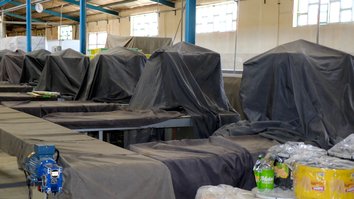Labourer Rasool Badshah has moved into a new house six months after a deadly earthquake rocked eastern Afghanistan, but without his mother, who was killed by collapsing walls.
More than 1,000 people were killed and tens of thousands made homeless after the 5.9-magnitude quake -- the deadliest in Afghanistan in nearly a quarter of a century -- struck the impoverished province of Paktika on June 22.
"When I reached here, my mother, brothers, everyone was already buried," Badshah, 21, told AFP, explaining how he rushed back to his village from Pakistan, where he was working.
Hundreds of earthquake-resilient concrete houses, many built by local labourers with the support of the United Nations (UN) refugee agency, have now been handed over to survivors who were until now living in makeshift tent cities.
![A truck carries humanitarian aid from the International Organisation for Migration (IOM) for earthquake survivors in the Afghan-Dubai village of Spera district, Khost province, Afghanistan, on June 27. [Ahmad Sahel Arman/AFP]](/cnmi_pf/images/2022/12/27/39941-000_32dc24a-585_329.jpg)
A truck carries humanitarian aid from the International Organisation for Migration (IOM) for earthquake survivors in the Afghan-Dubai village of Spera district, Khost province, Afghanistan, on June 27. [Ahmad Sahel Arman/AFP]
![In this photo taken on December 15, Afghans sit outside newly built houses constructed by the UN refugee agency (UNHCR) in Barmal district, Paktika province, Afghanistan. More than 1,000 people were killed and tens of thousands made homeless after a 5.9-magnitude quake -- the deadliest in Afghanistan in almost a quarter of a century -- struck the impoverished province of Paktika on June 22. [Wakil Kohsar/AFP]](/cnmi_pf/images/2022/12/27/39942-000_334a87g-585_329.jpg)
In this photo taken on December 15, Afghans sit outside newly built houses constructed by the UN refugee agency (UNHCR) in Barmal district, Paktika province, Afghanistan. More than 1,000 people were killed and tens of thousands made homeless after a 5.9-magnitude quake -- the deadliest in Afghanistan in almost a quarter of a century -- struck the impoverished province of Paktika on June 22. [Wakil Kohsar/AFP]
"We couldn't have built these houses, not even our children or grandchildren [could have]... we could not afford it. We were living in huts," Badshah said.
The UN High Commissioner for Refugees (UNHCR) said the new houses are equipped with solar panels, independent toilets and traditional heaters to help residents face harsh winters.
Even before the earthquake, Afghanistan has been in the grip of a humanitarian disaster since August 2021.
International development funding on which the South Asian country relied has dried up, and assets held abroad are still frozen.
The remote east where the quake struck had been neglected by authorities for many years, said survivor Bara Khan.
"After the earthquake, people came and saw that residents of the area were in trouble. We don't even have a clinic or a school," Khan said.
"Everybody has grown up illiterate."
The UNHCR will start work to build two schools and a clinic in the area, still strewn with rubble, after the winter.
Afghanistan is frequently hit by earthquakes, especially in the Hindu Kush mountain range, which lies near the junction of the Eurasian and Indian tectonic plates.

![This photo taken from a helicopter on December 15 shows tents and newly built houses constructed by the UN refugee agency (UNHCR) in Barmal district, Paktika province, Afghanistan. [Wakil Kohsar/AFP]](/cnmi_pf/images/2022/12/27/39940-000_334a84x-585_329.jpg)






